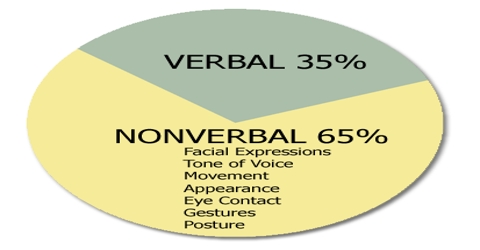Types of Non-verbal Communication
Non-verbal communication can take many forms depending on the situation, ability of communicators etc. According to one estimate, there are more than 0.70 million forms of non-verbal communication. The most common forms of non-verbal communication are as follows:
Facial Expression: Face is an important communicator. It is commonly said that face is the index of mind. It expresses the type of emotions or feelings such as joy, love, interest, sorrow, anger, annoyance, confusion, enthusiasm, fear, hawed surprise and uncertainty. Facial expression are indicated through mouth (open, wide or closed), eyelids (raised or lowered), nose (wrinkled or relaxed), cheeks (drawn up or back) and the forehead (lowered or raised).
Within the facial area eyes are especially effective for indicating attention and interest. However interpretations of facial expressions differ from culture to culture.
Gestures: Gestures are movements of the arms, legs, hands and head. Some authors opine that gesture is the deliberate body movement as because many gestures express specific and intentional meaning. For example, a wave of the hand has a specific meaning – “hello /good bye”
Alike facial expression, interpretation of some gestures also differ-across cultures. For example, in Europe, raising thumb is used to convey that someone has done something excellent while in some contrived the same gesture expresses “dam-care” to others threat.
Body language: Body language is another widely recognized form of non-verbal communication. Body movements can convey meanings and message. Body language may take two forms unconscious movements and consciously controlled movement. For example: when a person is bored, he may gaze around the room rather than look at the speaker or he may shift positions frequently. When a person is nervous, he may bite his nails or mash hair. These are usually made unconsciously. On the other hand, leaning forward toward the speaker to express interest is the case of conscious body movement.
Space and distance: Space and distance are significant non-verbal tools in the case of ‘organizational communication. A spacious and well-decorated room indicates a person’s position in the organization hierarchy and external people gets a message about his importance and authority only by visiting his room. Distance is another communication tool, which expresses-degree of intimacy and individual acceptance.
Touch: Touch is a widely used form of non-verbal communication tool. By touching, one can express a wide range of emotions. However, the accepted modes of touch vary depending on the gender, age, relative status, intimacy and cultural background of the persons.
Silence: Silence is a powerful tool of communication. It may have positive or negative meaning. In a classroom, silence indicates that students are carefully listening lectures. In the same way, though silence one can communicate lack of interest or a failure to understand.
















